Introduction

he Royal Naval Exhibition, organised by the Admiralty with the support of other relevant institutions — their members sitting on numerous committees, special committees and local committees — can be seen as yet another "refraction" of the Great Exhibition of 1851. It was one of a series of great shows put on in the capital and other large cities, to showcase the status, power and talent of Empire in those far-off days. Held in the grounds of the Chelsea Hospital, this one followed the Army Exhibition of the previous year and adapted some of its temporary structures there, but added about eight extra acres for outdoor drills, entertainment etc. (see the Official Catalogue, xxxiv).



Left to right: (a) Cover of the Official Catalogue & Guide. (b) Cover of the The Illustrated Handbook and Souvenir. (c) Some of the Nelson memorabilia shown in the The Illustrated Handbook and Souvenir, p. 12. [Click on all the images to enlarge them.]
In this exhibition, Nelson figured largely, with the popular Guide illustrating the display case containing his pigtail, "cut off after his death"(12). The Arctic section naturally paid nostalgic tribute to the lost Franklin Expedition and its subsequent search parties, with "the Franklin relics" on display (5). But the show also came right up to date with its Armstrong Gallery, and its focus on Lord Armstrong, whose portrait introduces the last section of the Guide (49).
The message was simple: blazoned over the entrance were the words, "It is on the navy, under the good providence of God, that our wealth, prosperity and peace depend" Guide, 4). According to the Royal Museums Greenwich site, the exhibition, held from 2 May to 24 October 1891 attracted 2,351,683 visitors, and was a huge success. — Jacqueline Banerjee
Account in the Illustrated London News

he space of fifteen acres, in the grounds of the Royal Military Hospital at Chelsea adjacent to the Thames Embankment, where the Royal Military Exhibition was held last year, is now occupied by the Royal Naval Exhibition, opened on Saturday, May 2, by the Prince of Wales. With reference to the Views here presented, we need only describe the general arrangement of the buildings, which are partly, under new and appropriate names, the same that were erected for the Military Exhibition, and partly, on the north side and to the eastward, comprise additional structures of a peculiar and interesting character.
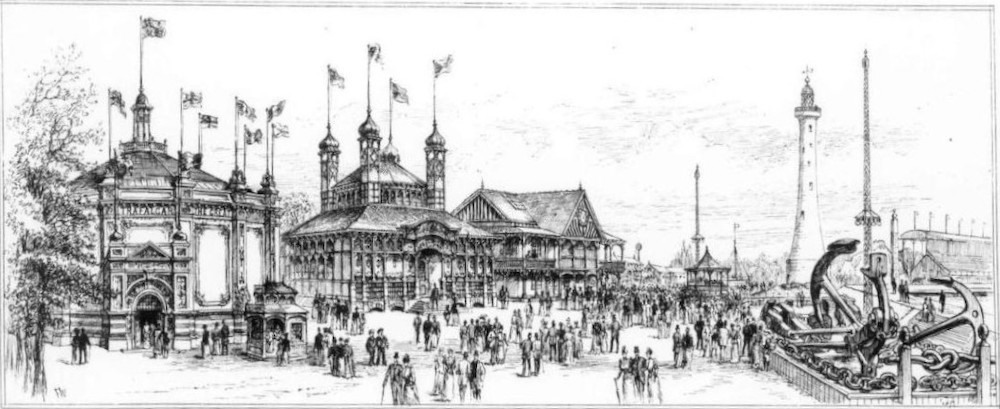
From the left: The Trafalgar Panorama; Pavilion of the P. and O. Company; and the Model of the Eddystone Lighthouse. Signed FW.
What is now called the Franklin Gallery is devoted to the Arctic Subdivision of the Navigation Section, and the relic or memorials of the Arctic expeditions, portraits, pictures, photographs, equipments, natural history, and ethnographical curiosities. The Arts Section is comprised in the Nelson, Blake, and Benbow Galleries, containing pictures and other itims of naval history. The Historic Loan Collection is in the Blake Gallery — a splendid collection of naval pictures, continued in the Benbow Gallery. Ihe Nelson and other galleries are rich in autographs, official papers, and mementoes of great men and great deeds. The Howe Gallery is that of miscellaneous exhibits, with those from the Victualling and Clothing Departments of the Navy; the Cook Gallery begins the Navigation Section, of which the Franklin Gallery is a subdivision. There are magnificent models of marine engineering in the large Seppings Gallery. So far the main building, to which are added the general offices, and some refreshment-rooms.
On the north side of the grounds, at the head of the arena are the St. Vincent Gallery, with its ordnance section, and the Armstrong Gallery, full of warlike material, and containing a 110-ton gun. This gallery alone is 230 ft. long and 43 ft. broad. The ordnance trophy and other such devices adorn their own department. At right angles is a still more extensive range of buildings, parallel with the fine lime-tree avenue. It is the Camperdown Gallery, 450 ft. by 50 ft., and is devoted to ship material of every description.
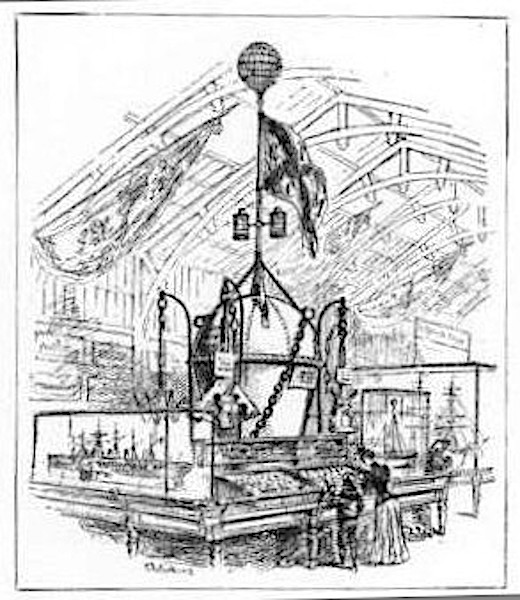
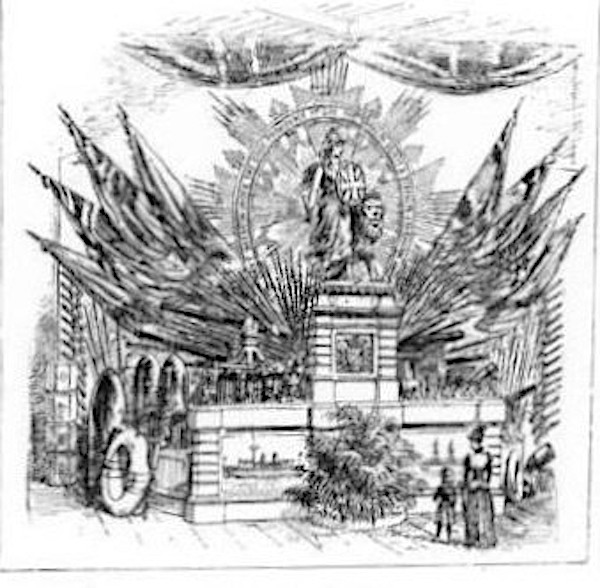
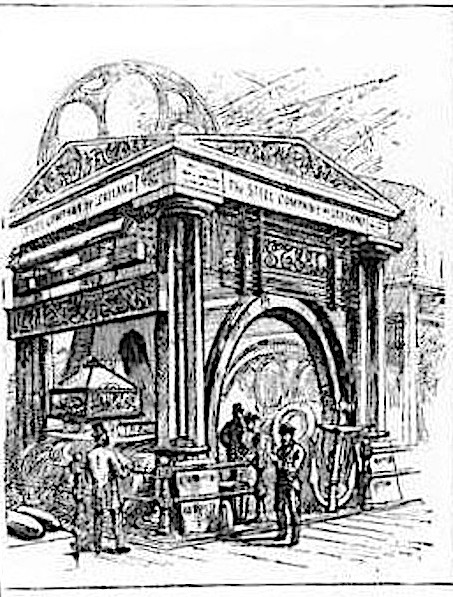
Left to right: (a) Telegraph Construction and Maintenance Company. (b) Ordnance Trophy. (c) Trophy of Steel. All signed FW.
In the eastern grounds are the Machinery Gallery, and a long narrow building adjoining the Embankment for the electric-lighting plant; the full-size model of Nelson’s last ship, the Victory; the kiosks of the P. and O. and other shipping and ship-building companies; the Trafalgar Panorama, the North Sea Trawler, the Arctic Pavilion, like an iceberg in aspect; and the model of the Eddystone Lighthouse, 170 ft. high and 44 ft. diameter at base, in which even the courses and size of the stones have been accurately copied. In this quarter are the refreshment pavilions, named after famous naval hostelries of the Marryat days, such as “The George,” the model working dairy, and Mr. John Furley’s station of the St. John Ambulance Association. The Telegraph Construction and Maintenance Company display specimens of cables and appliances, and models of the Great Eastern and other ships. The lake, an artificial reservoir of water, is provided for mimic combats between model ironclads, torpedo-boats, and batteries or forts.
More detailed accounts of the Exhibition must be reserved for a future occasion; but we need only here add a few words about the trophy erected by the Steel Company of Scotland (Limited), whose works are at Newton and Blochairn, near Glasgow. To explain our Illustration, it should be observed that the entrance, shown in the foreground, is a racer-path for a disappearing gun, for one of the first-class battle-ships. The other entrance is formed by a full-sized model of the engine columns sunplied to the steam-ship City of New York. The corner columns of the trophy are made up of channel-bars, rails, tram-rails, bulb T bars, and other steel, as rolled by the company. Among the castings shown is one of a Wright's patent improved Martin anchor, the sole right of manufacture of which is held by this steel company.
The opening ceremony, in spite of heavy rain, was attended by a large assembly of privileged spectators and of season-ticket holders. The Prince and Princess of Wales, with Princess Maud and the Duke of Clarence, the Duke of Edinburgh, and the Duke and Duchess of Connaught, arrived at a quarter before twelve, when a salute of guns was fired. The other members of the royal family present were the Duke of Cambridge, Princess Louise and the Marquis of Lorne, the Duchess of Albany, the Duchess of Fife, Prince and Princess Christian of Schleswig-Holstein, Prince and Princess Victor of Hohenlohe, Count and Countess Gleichen, the Hereditary Prince of Anhalt, and the Duke of Teck.
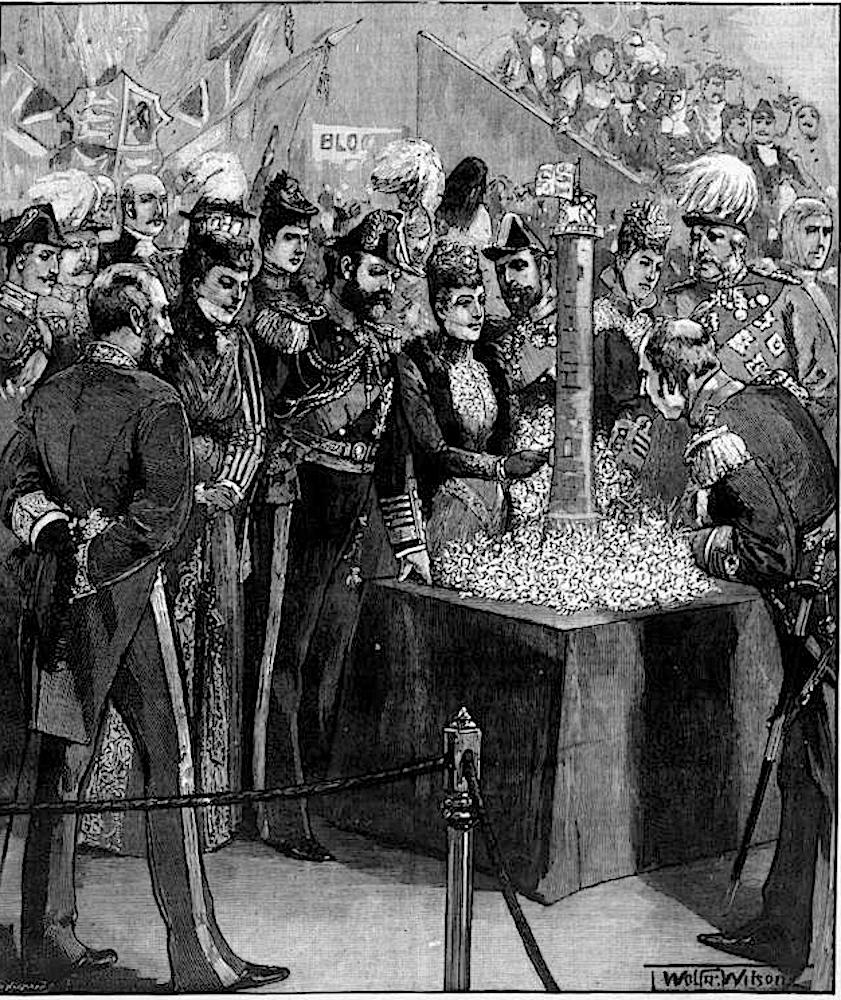
The Prince and Princess of Wales Opening the Naval Exhibition — front cover, illustrated by (Thomas) Walter Wilson, 1851-1912.
The Prince of Wales and the Duke of Edinburgh wore the full-dress uniform of Admirals of the Fleet; they, as well as the Duke of Cambridge, the Duke of Connaught, and the Duke of Clarence and Avondale, wore also the ribbons and insignia of the Garter. They were received by the First Lord of the Admiralty (Lord George Hamilton), the Right Hon. W. H. Smith, M.P., and the Executive Committee. They were escorted to the marquee near the lighthouse, amid loud cheers, by a hundred bluejackets, with the Devonport Royal Marine band, and an equal number of rank and file, and the band of the Chatham Division of the Royal Marine Light Infantry. The Greenwich boys and their band lined the route from the entrance to the dais. The National Anthem was played by the Marine band.
The marquee, in broad stripes of red and blue, was hand- somely decorated, with a trophy of flags and profusion of flowers. A large number of distinguished naval and military officers, members of Parliament, and others had places on or about the dais. After a prayer, read by the Archbishop of Canterbury, an address was read by the First Lord of the Admiralty, to which the Prince of Wales replied. The gold key of a model of a lighthouse was next presented to the Princess of Wales, which, inserted in the door of the lighthouse, let free an electric current, which fired a salute and loosed a flag at the summit of the lighthouse in the grounds. The Exhibition was then declared open by the Prince. The ceremony closed with the singing of a verse of “God bless the Prince of Wales” by the Greenwich boys. The Prince and Princess of Wales were conducted through the galleries of the Exhibition. His Royal Highness was presented with the official catalogue, splendidly bound in gold, real goldsmith’s work, showing the ancient war-ship, the Great Harry, and the newest war-ship, the Royal Sovereign, with emblematic dolphins, a wind-god, wreaths, and the Prince of Wales’s plume. This book was produced by Messrs. W. P. Griffiths and Sons, printers to the Exhibition.
Links to Related Material
You may use these images without prior permission for any scholarly or educational purpose as long as you (1) credit the person who scanned them, and the Internet Archive, and (2) link your document to this URL in a web document or cite the Victorian Web in a print one.
Bibliography
Official Catalogue & Guide. London: Griffiths and Sons, 1891. Internet Archive, from a copy in the University of California Libraries. (This 1/- catalogue of exhibits is not illustrated, although it has many advertisements.) Web. 28 December 2023.
"The Royal Naval Exhibition." The Illustrated London News. 98 (9 May 1891): front cover and 614-15. Internet Archive. Web. 28 December 2023.
Royal Naval Exhibition, 1891. London: Pall Mall Gazette Office, 1891. Internet Archive, from a copy in the University of California Libraries. (This cost 6d. and is illustrated.) Web. 28 December 2023.
"The Royal Naval Exhibition 1891 at Chelsea." RMG (Royal Museums Greenwich). Web. 28 December 2023.
Created 28 December 2023